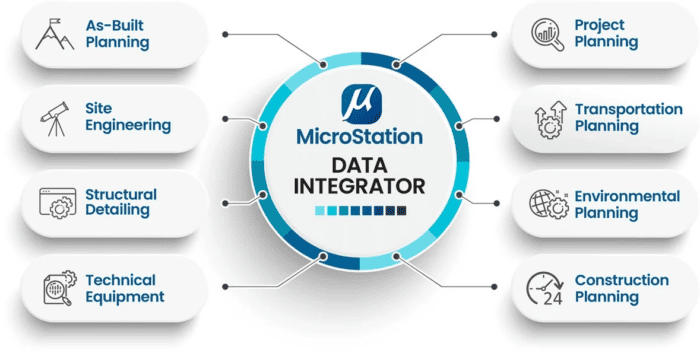Why a Shared Data Environment is Critical Path Technology
With the advancement of computer-aided design (CAD) software, came enormous benefits in process efficiencies and cost effectiveness. But the era of digital design has also resulted in the issue of enormous amounts of digital data being generated throughout the lifecycle of a building project, which can be overwhelming or even unmanageable for many organizations.
Regardless of whether it is a small renovation project or a massive university campus, centralized storage and sharing of this ever-increasing amount of information is a game changer for every step of the process from planning to design, to construction, and operation.
In this technology primer, we’re going to take you through why a shared data environment is imperative for your business and how to get there.
The Role of BIM
Building Information Modeling (BIM) is a method, a process that uses building data to make the design, construction, and operation of a building more efficient. The increasing adaptation of BIM is one of the most transformative developments in the digitization of construction. BIM improves almost all construction project outcomes, making them more cost-effective, sustainable, faster, and safer.
- CAD designers, architects, structural engineers, interior designers, and even clients can collaborate throughout the design process
- Instead of approaching each project in discrete phases, it’s easy to get cross-disciplinary input at each stage
- When the project is nearly complete, it takes less time to create the clash check and less time to cross-check each design element
- It is easy for CAD designers to use multiple design tools simultaneously and interchangeably without having to worry about updating multiple files
BIM provides CAD designers with exactly what it offers for the entire design and planning process: flexibility, accountability, and control. However, as a central communication and collaboration tool, the information and data used in any CAD and BIM process must be managed efficiently to achieve these desired results.
Where Does a Data Integrator Fit In
A data integrator is a technical system for storing information centrally. In such a system, all the data of a construction project is brought together from various sources, including BIM software, CAD software, spreadsheets, and more. And a powerful data integration tool not only provides a central system for data storage and management but allows you to seamlessly connect that data to the CAD and BIM tools used – improving the functions and results of BIM.
The right solution lets you:
- Always work with the most up-to-date information
- Have a single source of truth by combining collaborative processes with technological tools
- Deliver manufacturing information correctly the first time
- Consolidate everything relevant to the construction project, including design details, directories, schedules, contracts, reports, and model information, in one place
The Benefits of a Shared Data Environment
In engineering and construction, most captured data goes unused. That means a huge potential is lost, inevitably leading to waste: almost 50% of all reworks in construction are due to poor data and communication, according to a recent FMI survey.
Data integration is therefore one of the most effective tools that can be used in the construction sector to address those challenges. It enables a fully data-driven decision-making process throughout the lifecycle of a building – and cross all disciplines. Aside from the architects designing a building, everyone from plumbers to landscape architects, and every discipline-specific engineer can use such systems to make data-driven decisions in their respective work areas – improving outcomes for the entire team.
The undeniable benefits of such systems include saving time and resources, increasing efficiency in all areas of operations, and providing consistency and uniformity as well as contributing to the sustainable development goals of the projects. Deliver projects faster, with better results, and greater profitability.
The Solution
MicroStation is the missing piece to your digital arsenal. It can serve as a data integration tool for all existing CAD and BIM environments. MicroStation is known as a leading 2D and 3D CAD solution for industries from architecture to transportation projects, but the deep, robust feature set, and the rich support of various interchange industry file formats, that it’s known for, make it a powerful shared data environment as well.
No matter if you have a project that requires you to deliver as-built plans, transportation designs, or planning for environmental, construction, structural, technical equipment, and more, MicroStation can help you by bringing together all the project data and information and managing it one place. It is the common platform for all of your existing CAD and BIM data.
From 2D drafting to 3D modeling to visualization, from building design to civil engineering to construction management, MicroStation is the foundation for your data integration – a single tool so that you can have a single source of truth.
MicroStation data integration features include:
- More than 70 interfaces to existing CAD systems, including DWG, and it can convert data between MicroStation DGN and hundreds of other formats including GIS, Tabular datasets, Databases, Raster, Cloud sources
- Dynamic detection of reference files during upload and automatic creation of database links
- Title block integration automatically synchronizes MicroStation block/tag and field data with attributes
- General text data within MicroStation files is fully searchable with full-text search
- Access to CAD files from mobile devices without the need for the native application is possible as MicroStation is linked with Bentley Cloud Services
- Access to BIM Geometry and Data can be done via IFC Reading capabilities
- CAD viewing control of selective layer and reference file information without additional third-party viewing software is guaranteed
- ProjectWise check-out and check-in control is available within MicroStation software with automatic version management and corresponding drawing access
- Non-MicroStation file viewing and markup of 2D drawing and reference files without additional CAD licenses possible by default
- Server-side comprehensive batch plotting with direct network access to any worldwide network printing or plotting device is also included
Overall, MicroStation is the best tool for integrating all available CAD and BIM data due to its powerful capabilities, collaboration features, user-friendliness, and ongoing updates and improvements. Whether you are working on a small, simple project or a large, complex one, MicroStation can help you manage and combine all your CAD and BIM data, ensuring that your designs and drawings are accurate, comprehensive, and up to date.









